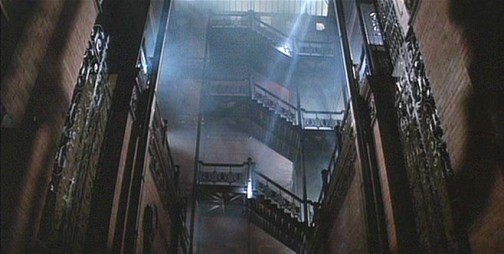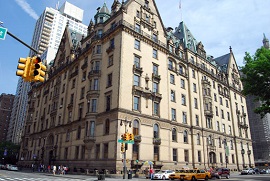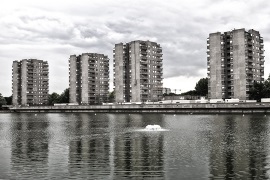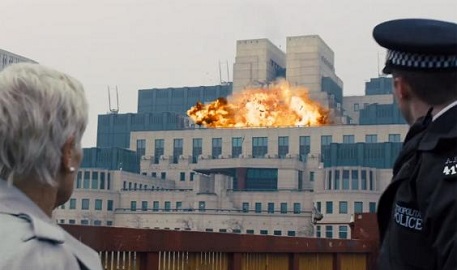Main author
Michael BrooksBuildings in film
[edit] High-Rise
Ben Wheatley’s 2016 film ‘High-Rise’, based on the cult novel by J.G. Ballard, centres around a fictional high-rise building in London’s docklands, in which the inhabitants gradually descend into debauched anarchy in a manner that, it is implied, is compelled by the nature of the building itself.
The original novel was intended as a social commentary on the kind of architecture designed by Erno Goldfinger and others during the 1960/70s that had the intention of shaping and influencing the behaviour of inhabitants in a new form of urban living.
[edit] Empire State Building – ‘King Kong’
The Empire State Building, in Midtown Manhattan, New York City, is one of the most iconic skyscrapers in the world. Standing at 443 metres tall (1,454 feet), it was the world’s tallest building between 1931 and 1971, and remains one of the tallest buildings in the United States. It is particularly distinctive for its art deco design, typical of pre-World War II architecture in New York, together with a series of steps in its profile that cause it to taper with height.
Culturally, the building is an icon, largely as a result of its appearance in the 1933 film ‘King Kong’ in which the eponymous ape scales the building whilst being attacked by fighter planes.
For more information, see Empire State Building.
[edit] Bradbury Building – ‘Blade Runner’
The Bradbury Building, located in downtown Los Angeles, California, is the city’s oldest landmarked building, having been built in 1893.
The exterior was designed in the vernacular Italian Renaissance Revival style popular at the time, with brown brick, sandstone and terra cotta detailing. When completed, it had the largest plate-glass windows in Los Angeles.
The interior is architecturally more notable than the exterior, with a five-storey central court topped with a skylight allowing it to benefit from natural lighting. The building includes geometric patterned staircases and wrought-iron and polished oak railings throughout. The central court features glazed and unglazed yellow and pink bricks, decorative ceramics, Italian marble and Mexican tiles.
Ridley Scott’s 1982 film ‘Blade Runner’ uses the building extensively, as one of the leading character’s apartment as well as for the climactic rooftop scene.
[edit] Casa Mila – ‘The Passenger’
More popularly known as La Pedrera, Casa Mila is a modernist building in Barcelona, and was the last civil building project designed by the architect Antoni Gaudi. Completed in 1912, it was inspired by the undulating face of a mountain range. It is now a popular tourist attraction, particularly because of the roof which is adorned with skylights, exits, fans and chimneys designed as sculptures or Catalan vaults (a type of low arch made of plain bricks) coated with limestone, broken marble or glass, in keeping with Gaudi’s unique style.
The rooftop appears in a scene in Michelangelo Antonioni’s 1975 film ‘The Passenger’ starring Jack Nicholson and Maria Schneider.
[edit] Millennium Mills – ‘Brazil’
Millennium Mills is a derelict industrial building in the London Docklands area of Silvertown. In 1933, it was rebuilt as a 10-storey art deco concrete building. In the early 1980s, along with most others in the Royal Docks, the mill was closed, a symbol of the gradual decline of Britain’s industrial strength. Since then the building has remained derelict.
It was featured prominently in Terry Gilliam’s 1985 dystopian film ‘Brazil’, as the setting for the surreal and Kafka-esque ‘Department of Records’ in which Jonathan Pryce’s character finds himself at the centre of a bureaucratic nightmare.
For more information, see Millennium Mills.
[edit] Fox Plaza – ‘Die Hard’
Fox Plaza is a post-modernist skyscraper in Century City, Los Angeles, California. It is the official headquarters of the film production company Twentieth Century Fox. At 35-storeys and 150 m (492 ft) high, it is one of the tallest building in the large business district of Century City.
It is most widely known for playing the part of Nakatomi Plaza in the 1988 action film ‘Die Hard’, in which the building was targeted by terrorists on Christmas Eve. Filming was undertaken whilst parts of the building were still under construction. The scenes of the building’s destruction were filmed using a scale model.
For more information, see Fox Plaza, LA.
[edit] The Dakota – ‘Rosemary’s Baby’
The Dakota is a co-operative apartment building located on the Upper West Side of Manhattan, next to Central Park. It was completed in 1884, with the influence of French architecture typical of New York housing at the time. It features high gables and deep roofs together with dormers, niches, balconies and balustrades inspired by North German Renaissance buildings.
The building was cast as The Bramford in Roman Polanski’s 1968 paranoid thriller ‘Rosemary’s Baby’ starring Mia Farrow. It is also infamous for being the former residence of John Lennon who was shot dead in 1980 on the street outside.
[edit] Timberline Lodge – ‘The Shining’
Timberline Lodge is located within the Mount Hood National Forest in Oregon, roughly 60 miles east of Portland. Local artisans built and furnished the lodge during the Great Depression and it was constructed between 1936 and 1938 by the Works Progress Administration.
The central head house section is hexagonal and 60 ft in diameter, with a six-sided stone chimney stack. At ground-level the exterior walls are heavy rubble masonry using boulders from the area, whilst heavy timber is used for the first floor upwards.
The lodge was used as the exterior location for the Overlook Hotel in Stanley Kubrick’s 1980 classic ‘The Shining’ in which Jack Nicholson stars as a writer descending into madness. In the film the hotel is supposedly built on an Indian burial ground.
[edit] Thamesmead Housing Estate – ‘A Clockwork Orange’
Thamesmead was a purpose-built housing estate that was supposed to help alleviate the housing shortage that faced London in the post-war era. The complex was designed as a mix of modernist town houses, medium-rise and 12-storey blocks system-built in concrete following the Brutalist style of the 1960/70s. The design also allowed for artificial lakes and reactional areas, linked to shops and accommodation by multi-level pedestrian walkways.
Blighted by poor transport links to central London, Thamesmead quickly became a ‘sink estate’, used by local councils to house problem families and new immigrants.
In 1971, Stanley Kubrick used the Tavy Bridge area, as well as Southmere Lake, as the setting for his surreal dystopian film ‘A Clockwork Orange’, which depicted the estate as a bleak futurist landscape roamed by violent gangs of ‘droogs’.
[edit] Trinity Square Car Park – ‘Get Carter’
Trinity Square car park was a prominent high-rise landmark on the Gateshead skyline. Completed in 1969, the car park was designed by Owen Luder to have capacity over seven tiers of parking decks for 600 cars. A shopping centre made up the first two storeys, with the decks raised above on piloti columns.
The edges of each level were pitched outwards creating a slanted wave-effect profile, with a section of each floor raised at an angle to accommodate interior ramps. Two supporting towers contained stair and lift access. The design allowed for uninterrupted levels, meaning that the structure was open and the sky visible through each level.
The car park featured prominently in Mike Hodge’s 1971 classic ‘Get Carter’ in which Michael Caine took on local gangsters and crooked architects, one of whom plans to open a swanky restaurant-bar on the top floor. Despite being heralded as a landmark example of the Brutalist form, and coming to be known as the ‘Get Carter Car Park’, it was demolished in 2010 to be replaced by a new shopping complex.
[edit] Neuschwanstein Castle – 'Chitty Chitty Bang Bang'
Neuschwanstein Castle, located on a hill in southwest Bavaria, Germany, served as the setting for Baron Bomburst's castle of Vulgaria,visited by the Potts family in their flying car.
For more information, see Neuschwanstein Castle.
[edit] Griffith Observatory – ‘Rebel Without a Cause’
Griffith Observatory is positioned on the south-facing slope of Mount Hollywood in Los Angeles’ Griffith Park. The building was designed by the astronomer Russell Porter who wanted a domed observatory that offered exceptional rooftop views. It was built inexpensively using concrete and steel, with the domes made of copper.
The design was an amalgamation of grand and monumental styles which one journalist at the time compared to a ‘Roman temple, Moorish mosque or mausoleum’, and is today seen as an emblem of Los Angeles.
The observatory featured in two key scenes of the iconic 1955 film ‘Rebel Without a Cause’. A bust of its star James Dean is located outside the observatory.
For more information, see Griffith Observatory, LA.
[edit] SIS Building – ‘The World is not Enough’, ‘Skyfall’, ‘Spectre’
The Secret Intelligence Services (SIS) Building, more commonly known as the MI6 Building, is the headquarters of the British Secret Intelligence Service, situated on the Albert Embankment section of the River Thames next to Vauxhall Bridge.
The building was completed in 1994 and has come to be recognised as one of London’s most distinctive structures due to architect Terry Farrell’s Mayan and Aztec temple design translated into a post-modern style.
It has featured prominently in several recent films of the James Bond franchise, including ‘The World Is Not Enough’ in 1999 when part of the building appeared to be blown up in a terrorist attack, again in 2012’s ‘Skyfall’, and 2015’s ‘Spectre’ in which it was portrayed as a ruin awaiting demolition.
For more information, see SIS Building.
[edit] 55 Central Park West – ‘Ghostbusters’
55 Central Park West is a 19-storey housing co-operative located in Manhattan, designed by the firm Schwartz and Gross. When it was completed in 1929, it was the first fully art deco structure on the west side of Central Park. The exterior is architecturally distinctive due to the way its brick façade changes shade from deep purple to yellow-white as it rises from the ground.
It is popularly known as the ‘Ghostbusters Building’ as it featured prominently in the classic 1984 film starring Bill Murray. Despite being synonymous with the film, it is actually portrayed as being taller and with a different roof design.
[edit] White House – ‘Independence Day’
The White House in Washington D.C. has been the official residence of the President of the United States since 1800. Palladian architecture had inspired many buildings of monumental style in Western Europe, and the White House’s southern façade is a combination of the Palladian and neoclassical architectural styles. The ground floor is rusticated in the Palladian fashion with a neoclassical projecting bow of three bays at the centre of the façade.
The White House is shown in the 1996 blockbuster 'Independence Day' being destroyed by an alien spaceship, in an iconic moment that would inspire countless films thereafter to incorporate the destruction of other famous landmarks.
[edit] Randy’s Donuts – various
Randy’s Donuts is a drive-in bakery in Inglewood, near Los Angeles International Airport. The building’s style is typical of programmatic architecture that was very common throughout Southern California in the first half of the 20th century. During the 1950s, there was a trend for designing buildings in the shape of the product sold there, and accordingly the giant donut was built by structural engineer Richard Bradshaw.
As an icon of 1950s Los Angeles, the building has featured heavily in pop culture, including the films ‘Mars Attacks!’, ‘Into the Night’, ‘Stripped to Kill’, ‘Breathless’, ‘California Girls’, ‘2012’, ‘Iron Man 2’, ‘Get Shorty’, ‘Volcano’, and ‘Crocodile Dundee in Los Angeles’.
[edit] Related articles on Designing Buildings
- An art deco cinema on wartime Orkney.
- Architecture of concert stage designs.
- Best cinema architecture in the UK.
- Building of the week series.
- Buildings in music.
- Buildings that were never realised.
- Eight most impressive skyscrapers under construction in 2016.
- Infrastructure and film: Five iconic movies that civil engineers helped bring to life.
- London’s West End Cinemas.
- Skyscraper.
- Tallest buildings in the world.
- Unusual building design of the week.
Featured articles and news
Key points for construction at a glance with industry reactions.
Functionality, visibility and sustainability
The simpler approach to specification.
Architects, architecture, buildings, and inspiration in film
The close ties between makers and the movies, with our long list of suggested viewing.
SELECT three-point plan for action issued to MSPs
Call for Scottish regulation, green skills and recognition of electrotechnical industry as part of a manifesto for Scottish Parliamentary elections.
UCEM becomes the University of the Built Environment
Major milestone in its 106-year history, follows recent merger with London School of Architecture (LSE).
Professional practical experience for Architects in training
The long process to transform the nature of education and professional practical experience in the Architecture profession following recent reports.
A people-first approach to retrofit
Moving away from the destructive paradigm of fabric-first.
International Electrician Day, 10 June 2025
Celebrating the role of electrical engineers from André-Marie Amperè, today and for the future.
New guide for clients launched at Houses of Parliament
'There has never been a more important time for clients to step up and ...ask the right questions'
The impact of recycled slate tiles
Innovation across the decades.
EPC changes for existing buildings
Changes and their context as the new RdSAP methodology comes into use from 15 June.
Skills England publishes Sector skills needs assessments
Priority areas relating to the built environment highlighted and described in brief.
BSRIA HVAC Market Watch - May 2025 Edition
Heat Pump Market Outlook: Policy, Performance & Refrigerant Trends for 2025–2028.
Committing to EDI in construction with CIOB
Built Environment professional bodies deepen commitment to EDI with two new signatories: CIAT and CICES.
Government Grenfell progress report at a glance
Line by line recomendation overview, with links to more details.
An engaging and lively review of his professional life.
Sustainable heating for listed buildings
A problem that needs to be approached intelligently.
50th Golden anniversary ECA Edmundson apprentice award
Deadline for entries has been extended to Friday 27 June, so don't miss out!
CIAT at the London Festival of Architecture
Designing for Everyone: Breaking Barriers in Inclusive Architecture.
Mixed reactions to apprenticeship and skills reform 2025
A 'welcome shift' for some and a 'backwards step' for others.
























































